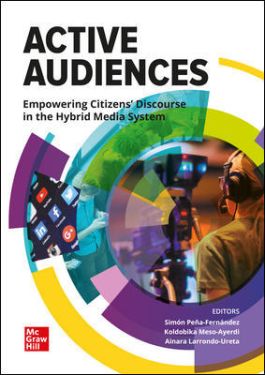Active audiences (POD)
1. Pere Freixa-Font, Mario Pérez-Montoro & Lluís Codina-Bonilla. Active audiences and structured journalism: Questions, doubts and good practices
2. Scott Eldridge. Legitimating new media actors: Unwelcome strangers to the journalistic field
3. Carlos Ruiz-Caballero, Jaume Suau-Martínez & Pere Masip-Masip. Listening to the user: Quality perception of participatory journalism
4. Laura Teruel-Rodríguez, Elena Blanco-Castilla, Hada Sánchez-Gonzáles & María Sánchez-González. Active users and interactive journalism projects
5. Jose A. García-Avilés. How news organizations face disruption in a networked environment: Exploring the implementation of innovations in media labs
6. Elvira García-de-Torres, Concepción Edo-Bolós, Pedro Jerónimo, LyudmylaYezers´ka & Claudia Herrera. Guardians of tradition: The use of crowdsourcing and user-generated content by Ibero-American journalists.
7. Agustin Rivera-Hernández, Antonio Méndez-Nieto, Jon Sedano-Amundarain & Bella Palomo-Torres. Managing 2.0 newsrooms: The challenge of understanding audiences
8. Gerson Luiz Martins. Content quality in cyberjournalism: Spain and Brazil comparative study in reference news portals
9. Maria Clara Estrêla-Oliveira, Jacqueline Lima-Dourado, Juliana Fernandes-Teixeira & Denise Maria Moura-da-Silva-Lopes. The incursion of Brazilian free-to-air TV on streaming services: Engaging the audiences in times of multiplatform content
10. Ainara Larrondo-Ureta, Simón Peña-Fernández & Irati Agirreazkuenaga-Onaindia. Transmedia apps designed for young audiences: Their implications and use in the context of public service media
11. Laura Pérez-Altable, Rosa Pérez-Arozamena, Juan Linares-Lanzman, Javier Odriozola-Chéné, Ariadna Fernández-Planells, Ana Serrano-Telleria & Javier Díaz-Noci. The crisis, the people and the media: How digital public opinion debates on economic inequality
12. David Puertas-Graell & Pere Masip-Masip. Audiences and sports journalism in Spanish TV programs: Building a transmedia continuum
13. Koldobika Meso-Ayerdi, Jesús Ángel Pérez-Dasilva & Terese Mendiguren-Galdospin. Twitter changes the relationship between actors and the audience in professional football
14. Denis Renó. The image as protagonist of cyber journalism with large format in the new media ecology: The transmedia journalism
15. Ana Serrano-Tellería. Journalism, transmedia & design thinking within mobile devices
A media system based on a small number of sources, extremely hierarchical and mainly targeting a passive mass audience, has evolved towards a context where the number of media has exponentially multiplied, audiences are highly fragmented and increasingly active, with almost endless options for news consumption. This new scenario is described as a hybrid media system, where old and new media co-exist.
The first great transformation in the hybrid media system has been the confluence of a great number of actors able to generate information. The second great transformation in the hybrid media system is the empowerment of audiences. Citizens are now ready and able to generate content on an unpreceded scale, especially via social networks.
Nevertheless, the research carried out so far shows that the number of citizens who produce news or contents related to public affairs is reduced. Audiences continue to grant journalists and media the role of primary gatekeepers on the news agenda. However, they also demand to be involved and interact with the content produced by the media and journalists. The spaces for user participation created by online media and social networking platforms constitute public spaces in which citizens can share information, express their opinions and react to the opinions of others.
In a hybrid media system scenario, audiences have become active, and their voice is now more powerful. This book tries to analyze this phenomenon from multiple perspectives.

